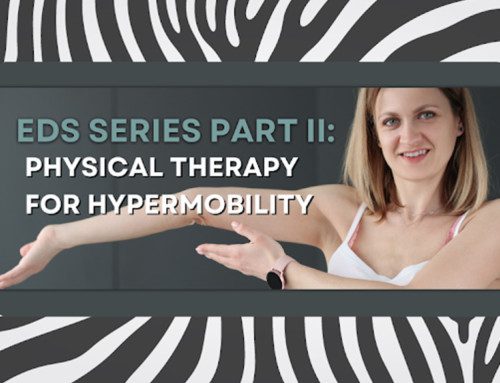Welcome to SetPT’s EDS blog series! My name is Morgan Panzer – I’m a physical therapist at SetPT and specialize in treating the Ehlers-Danlos Syndromes (EDS), Hypermobility Spectrum Disorders (HSD), and Postural Orthostatic Tachycardia Syndrome (POTS). These conditions, particularly EDS, are complex and impact multiple body systems. This series aims to explore EDS in detail to break down some of these complexities.
In this four-part series, we will discuss:
- What EDS is and how it’s diagnosed
- How we treat EDS in physical therapy and frequently-asked questions
- Tips, tricks, and recommended products to help manage EDS at home
- Insight on pelvic health concerns in EDS from our pelvic floor PT, Aimee Schuh
What is EDS?
The Ehlers-Danlos Syndromes (EDS) are a group of connective tissue disorders. Connective tissues (think tendons, ligaments, fat, cartilage, and even skin) help to form, support, and protect the body’s many systems. They are fundamental to your body’s function and exist in every nook and cranny, so when dysfunction occurs within this system, a lot can go wrong.
There are currently 13 types of EDS which have been defined based on their symptoms and underlying cause:
- Arthrochalasia EDS (aEDS)
- Brittle Cornea Syndrome (BCS)
- Cardiac-Valvular EDS (cvEDS)
- Classical EDS (cEDS)
- Classical-Like EDS (clEDS)
- Dermatosparaxis EDS (dEDS)
- Hypermobile EDS (hEDS)
- Kyphoscoliotic EDS (kEDS)
- Musculocontractural EDS (mcEDS)
- Myopathic EDS (mEDS)
- Periodontal EDS (pEDS)
- Spondylodysplastic EDS (spEDS)
- Vascular EDS (vEDS)
Click here to learn more about the different types of EDS.
All but one type of EDS is linked to a genetic variant, that exception being hypermobile Ehlers-Danlos Syndrome (hEDS). Researchers have been working hard to find the genetic variants related to hEDS and are inching closer each day. It is currently believed that this subtype is caused by a combination of variants instead of just one, which likely explains why the genetic markers have yet to be found.
Although each type of EDS presents differently, there are some overarching similarities between the types:
Joint Hypermobility and Instability
A hallmark sign of EDS is joint hypermobility, meaning joints that move more than they should. Those who identify as being “double-jointed” or particularly flexible likely deal with joint hypermobility. Sometimes, joint hypermobility is so severe that it leads to subluxations, where the bones making up the joint move out of place to the point that their surfaces are only partially touching. If the bones in the joint no longer touch at all, a dislocation has occurred. These can be painful, and repeated subluxations and dislocations can lead to even more mobility, fueling the cycle.
Muscle Tension and Weakness
Individuals with EDS often describe their muscles as feeling tight, knotted, and constantly in painful spasm. I am often asked, If my joints are loose, why does everything feel so tight? When joints are too loose, the body uses other defense mechanisms to protect and stabilize them instead. Some of the body’s most adaptable structures capable of doing this are muscles, so they tighten up to protect the area.
Skin Changes
Those with EDS often have soft, velvety skin that can be easily pinched and lifted from the body. It is also prone to bruising, tearing, slow wound healing, and abnormal scarring.
- Other Co-Morbidities and Dysfunction
- Scoliosis, an abnormal curvature of the spine.
- Gastrointestinal issues such as bloating, nausea and vomiting, pain, absorption issues, and difficulty swallowing.
- Hernias, where organ or tissue squeezes through a weak spot in muscle or fascia. Common types of hernias in EDS include inguinal, femoral, umbilical, and hiatal.
- Organ prolapses, where weak muscles and lax ligaments cause drooping of organs. This occurs most often to organs in the pelvic floor such as the uterus, vagina, bladder, small bowel, and rectum.
- Autonomic dysfunction such as Postural Orthostatic Tachycardia Syndrome (POTS), which we also treat at SetPT.
- Mast Cell Activation Syndrome (MCAS), where the body’s mast cells release chemicals that cause allergic-type reactions to things that typically don’t cause allergies. This leads to frequent hives, rashes, GI issues, inflammation, and swelling of multiple body systems.
So how does EDS get diagnosed?
A clinical geneticist will order a connective tissue panel to diagnose a type of EDS, which scans your genome for genetic variants associated with the aforementioned types of EDS. This information, in conjunction with specific diagnostic criteria, informs a diagnosis made by the geneticist or knowledgeable physician.
What about hypermobile EDS, hEDS? How do you get diagnosed if there’s no known gene yet?
Hypermobile Ehlers-Danlos Syndrome (hEDS) is the most common type of EDS at this time, which makes its unknown genetic basis all the more frustrating. Fortunately, EDS experts from The International Consortium on Ehlers-Danlos Syndromes & Related Disorders developed diagnostic criteria in 2017 to better diagnose hEDS.
Included in the criteria is a screening tool called the Beighton Score, a nine-point scale that evaluates an individual’s joint hypermobility. An individual receives one point if they can:
- Bend the pinkie back more than 90 degrees – 1 point for each side
- Touch the thumb to the forearm with elbow straight – 1 point for each side
- Hyperextend the knees backward more than 10 degrees – 1 point for each side
- Hyperextend the elbows backward more than 10 degrees – 1 point for each side
- Place the palms of the hands flat on the floor without bending the knees – 1 point
Many individuals screened for hEDS are familiar with the Beighton Score, but more information is required for a proper diagnosis. History of mitral valve prolapse, hernias, dental crowding and/or high palates, as well as other specific factors require consideration.
A clinical geneticist must also rule out other types of EDS and conditions that have a hypermobility component (e.g. Marfan Syndrome or Loeys-Dietz Syndrome) through appropriate genetic testing. If these can be ruled out, geneticists or EDS-knowledgeable physicians can then use the hEDS diagnostic criteria to inform their diagnosis.
So what if I don’t meet the diagnostic criteria for any type of hEDS? I still have so many matching symptoms.
It can be frustrating to identify so closely with a condition but to not formally meet the criteria for diagnosis. There are still many unknowns about how hEDS manifests, and until we find out more, we’re a bit stuck.
Those who don’t meet the criteria for hEDS are often diagnosed with Hypermobility Spectrum Disorder (HSD). HSD classifies individuals with symptoms that manifest similarly to hEDS but don’t quite meet the criteria. Ultimately, HSD and hEDS are addressed similarly in a physical therapy setting and are treated with the same level of care and consideration at SetPT.
Why the zebra?
The zebra was adopted as the mascot of the EDS community, with many individuals identifying as “zebras.” And there’s a good reason for it!
Medical students are traditionally taught in school to expect the most common diagnosis when observing a collection of symptoms. This is fair – common things happen, well, more commonly. Thus, they were told, “when you hear hoofbeats behind you, expect a horse. Don’t expect to see a zebra.”
But what about those times when the answer or diagnosis isn’t the common one? Every so often, there might be a zebra instead. This is what so many individuals in the EDS community identify with. No two zebras have the same set of stripes. And much like zebras, every individual with EDS or HSD presents with a different collection of symptoms in different areas, all with different responses to different treatments. We can attest to this at SetPT!
Stay tuned for Part II of our EDS Series, where we’ll discuss the different ways we treat EDS and HSD in physical therapy. I’ll also answer a few frequently asked questions I receive from patients about EDS and HSD.
Sources:
https://www.ehlers-danlos.com/eds-types/
https://www.ehlers-danlos.com/what-is-eds/
https://ehlersdanlosnews.com/types-of-ehlers-danlos-syndrome/
https://onlinelibrary.wiley.com/doi/10.1002/ajmg.c.31552





